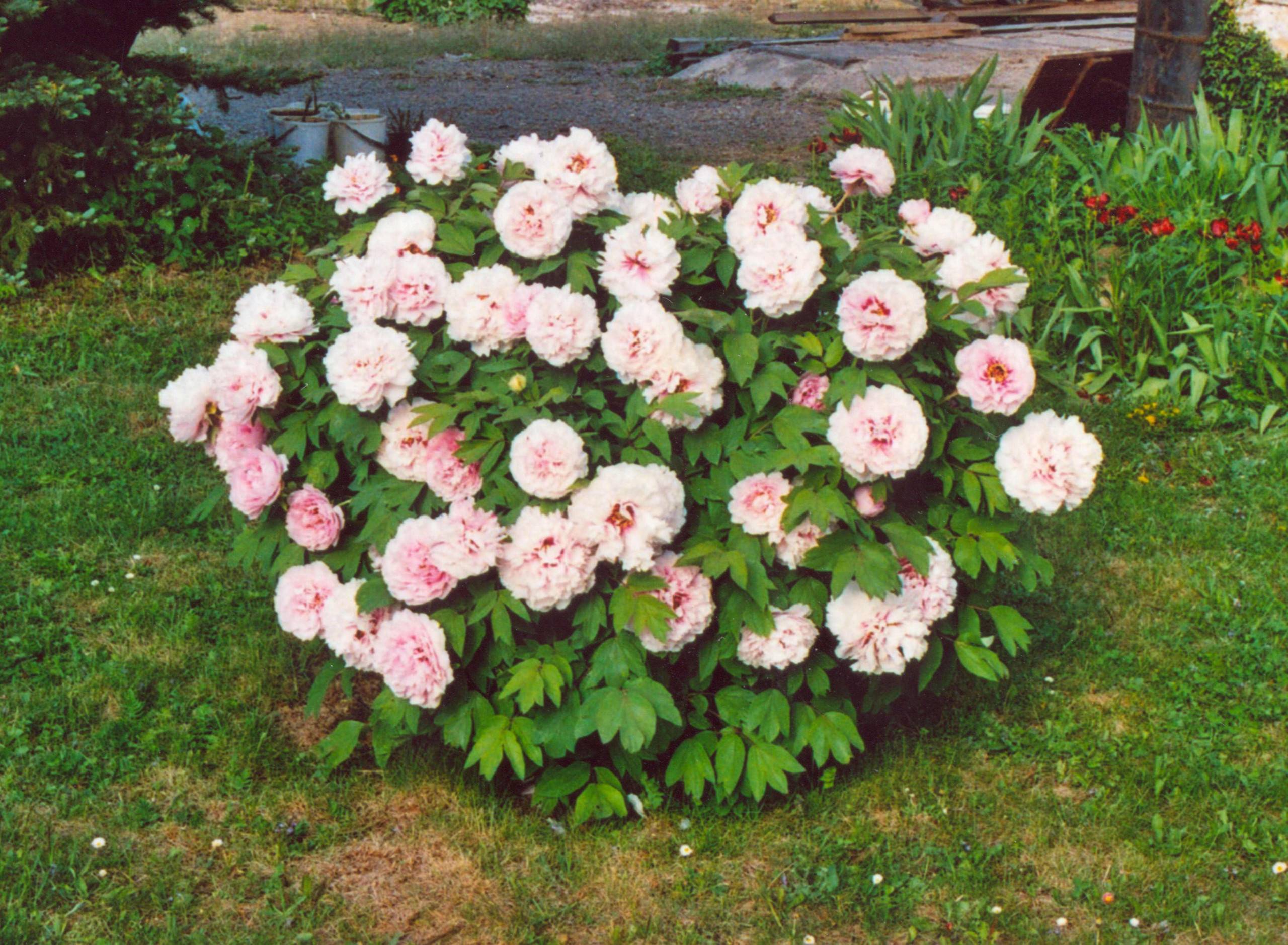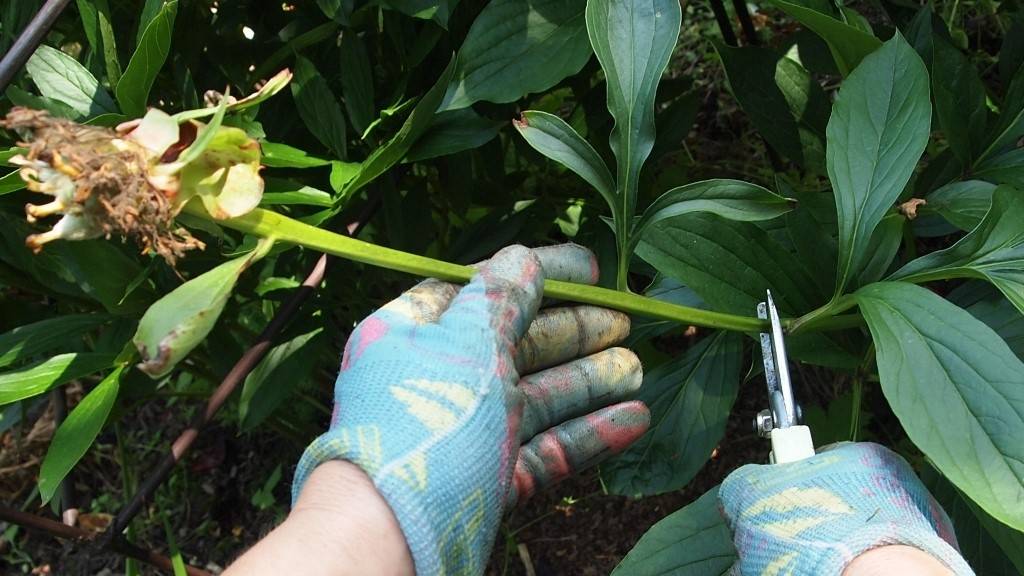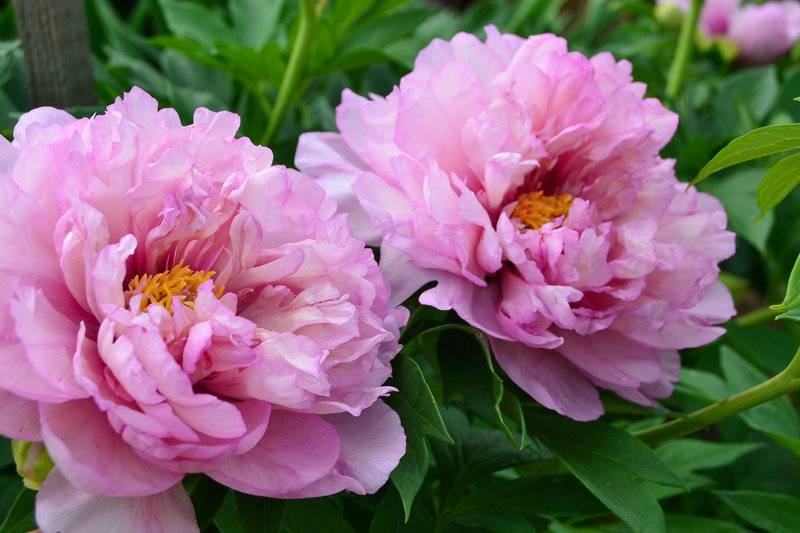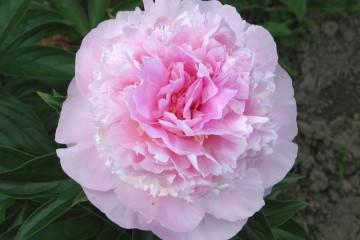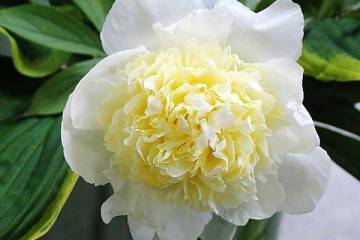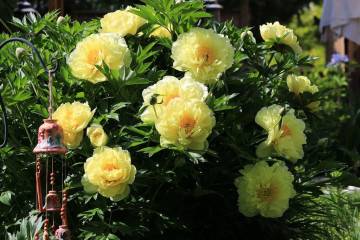Peony First Arrival (Paeonia First Arrival)
Content:
The First Arrival variety belongs to the Ito-peony line. The prefix Ito in the name of the hybrid means that it is obtained as a result of hybridization of tree-like and lactic-flowering peonies. For the first time such a manipulation was carried out by the Japanese breeder Toychi Ito in 1948. In honor of the scientist, all such hybrids are named with the prefix Ito.
Peony Ito First Arrival (Paeonia Itoh First Arrival) - what is this variety, history of creation
Peony Fest Arrival was obtained by the American breeder Roger Anderson in the 90s of the 20th century.
Brief description, characteristic
Large semi-double flowers of lilac color. There are dark spots at the base of the petals. Flowers brighten as they ripen. The diameter of the flower is up to 25 cm. The bush is compact, up to 80 cm high. By the timing of flowering - early.
The foliage of the variety has an interesting feature: in the fall it turns red, so the bush becomes an additional decoration of the garden.
Advantages and disadvantages of the variety
Any variety is good with certain characteristics.
Benefits:
- friendly flowering;
- high decorativeness;
- frost resistance;
- compact bush;
- stiff peduncles.
Disadvantages:
- inconsistent color of the flower.
Use in landscape design
The compact peony bushes First Arrival itoh are ideal as tapeworms, but in group plantings with other peonies they are just as good. They are planted in curbs.
Growing a flower, how to plant it in open ground
Peonies, planted in a suitable place, practically do not require care, but certain simple rules must be followed.
Planting by root cuttings
Root cuttings are areas of rhizomes 2-5 cm long. Such a cuttings must have a bud and a root. Cuttings are harvested in July-August. Breeding order by root cuttings:
- The rhizome is dug up, cleaned of earth and old roots.
- Divide the rhizome into cuttings.
- Planting material is soaked for 2 hours in a pink solution of potassium permanganate for disinfection.
- The cuttings are dried, the cuts are sprinkled with crushed coal, left for 12 hours to dry.
- Cuttings are planted in the prepared bed at a distance of 15 cm from each other.
The plot with cuttings is shaded from the sun, regularly watered, weeds are weeded, mulch for the winter. The first flowers will appear on plants in 3 years.
What time is the boarding
Most often, a peony is propagated by dividing the rhizome. Ito hybrids are transplanted in August-September. The plant will get stronger by the cold and build up a good root system.
Location selection
Can grow in one place and feel great up to 30 years old. Conditions for landing:
- open, sunny place, in the shade the peony will not bloom;
- nutritious soil, loose, with a neutral reaction;
- groundwater at the site should not be close;
- high-quality drainage is provided;
- absence of other perennials, buildings nearby.
How to prepare the soil and flower for planting
A place for planting the peony variety Ito First Arrival is prepared in about a month:
- Digging a hole with a depth and diameter of 60 cm.
- At the bottom, 10 cm of drainage is laid (expanded clay, broken brick).
- To adjust the pH, a handful of dolomite flour and ash are added to the well.
- Contribute 2 tbsp. l superphosphate.
- The hole is filled ½ with a mixture of soil, forming a mound.
Plant preparation:
- All the stems are cut off the peony.
- Carefully dig out the rhizome, being careful not to damage the adventitious roots.
- The soil is removed from the roots so that the buds are visible.
- The accessory roots are cut, leaving 10-12 cm.
- The rotted, dried out areas of the rhizomes are removed by sprinkling the cuts with crushed coal.
- The rhizome with a pruner or a sharp knife is divided into parts so that in each division there are 2-3 developed buds and 2 adventitious roots.
Planting procedure step by step
For landing you need:
- The rhizomes are placed in a prepared and well-spilled hole.
- The upper kidney is positioned flush with the ground.
- They fill the hole with soil, compacting it.
- The landing site is mulched with hay, sawdust.
- Watering.
Peony Ito hybrid First Errival does not propagate by seeds. Plants grown from seeds collected from hybrids do not carry parental characteristics.
Plant care First Errival
Peony hybrid is an unpretentious plant. It tolerates cold winters and hot summers well. Will bloom with minimal maintenance.
Watering and feeding
In the spring, the hybrid needs regular watering:
- the temperature of the water for irrigation is at least 20 ° C, the roots simply will not assimilate cold water.
- do not allow the soil to dry out. The soil, compressed in the hand, should retain the shape of a lump.
- water abundantly, but avoid stagnation of moisture in the soil;
- watering is carried out at the root, preferably in the evening or in the morning.
Three dressings are carried out per season:
- in early-late April - nitrogen and potassium are introduced;
- at the very beginning of flowering - complex fertilizer;
- at the end of August - potassium and phosphorus.
Fall dressing is very important for a successful wintering and lays down the flowering quality for the next year.
Mulching and loosening
You need to loosen the soil around the bush after each watering. Loosening depth - 5-7 cm. The procedure is necessary to improve root respiration.
Mulching the soil around the plants is recommended to get rid of weeds and regulate soil moisture.
Preventive treatments
As a prevention of the appearance of rot and rust, peony bushes are treated with a fungicide in early April, in the first and last ten days of May. You can also cultivate the soil around a newly planted peony.
Peony Blossom Fest Arrival
The blooming peony is beautiful! Caring for him during this period should be special.
A period of activity and rest
All peonies have two periods of active root growth. In the spring, after the soil temperature rises to +5 ° C and until the end of flowering. In autumn, when the suction roots turn into storing rhizomes, thanks to which the plant hibernates.
Care during and after flowering
At the very beginning of flowering, the lateral buds on the bush are plucked, this will enable the central ones to "gain mass", to become larger.
Faded buds are cut with a sharp pruner, leaving part of the stems on the bush. It is imperative to remove fallen petals from the ground around the peony, otherwise they will become a home for pests and pathogens.
What to do if it does not bloom, possible reasons
A peony may not bloom for the following reasons:
- unsuitable landing site;
- the age of the bush is under 2 years old or over 30;
- strong deepening when landing;
- excess nitrogen in the top dressing. This is noticeable by the rich greenery, powerful leaves and stems;
- acidic soil;
- damage by diseases and pests.
Peonies after flowering
A plant that has finished blooming is especially vulnerable. It must recover and gain strength in order to please with abundant flowering next summer.
Transfer
Immediately after flowering, the peony cannot be transplanted. You need to give the plant time to recover.
Pruning
The peony is by no means cut off immediately after flowering! Otherwise, the bush will not store nutrients for the winter, the roots may freeze out.
Preparing for winter
The stems are cut for the winter, leaving hemp of 10-15 cm. First Arrival does not need shelter for the winter, it is frost-hardy. You can only cover plants that were planted in the fall and did not have time to get stronger.
Diseases, pests and ways to control them
Peony First Arrival is rarely affected by diseases and pests. If agricultural technology is violated, it can be affected by gray and root rot, rust. All these are fungal diseases. Fight against similar diseases:
- Establish an irrigation regime.
- Treat the bush with a fungicide or Bordeaux mixture.
- Do not forget about autumn pruning and tops burning.
Pests
The insects that attack the First Arrival peony are aphids, spider mites. A strong soap solution, an infusion of garlic, and, in extreme cases, systemic pesticides will help against them.
Gall nematodes are especially dangerous for peony. Signs of infection:
- wilting with regular watering;
- lack of flowering;
- tumors-growths appear on the rhizomes.
The disease does not respond to treatment, the bush affected by nematodes is dug up and burned. It is not recommended to plant a new cousin in the same place.
Peony is one of the most popular garden plants. Bouquets from it are beautiful and stand in vases for a long time. With a little patience and care, there will be a beautiful, fragrant flower on the site.

